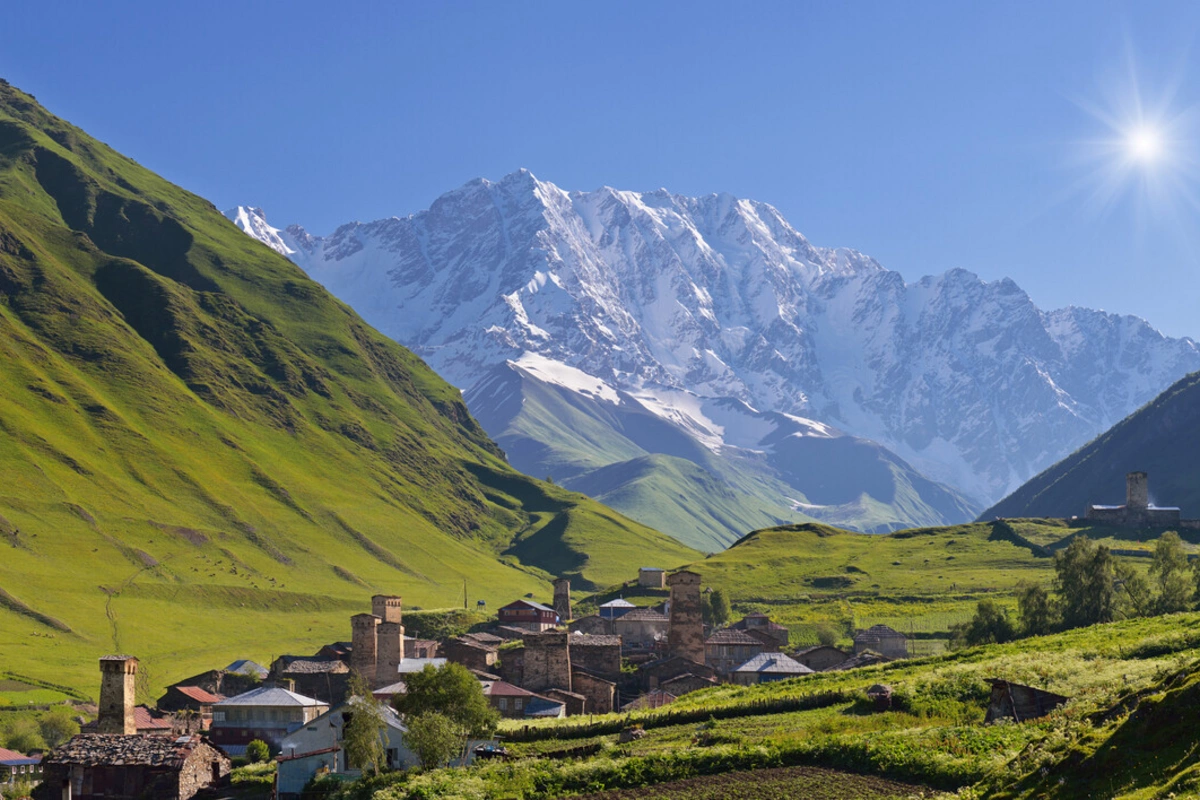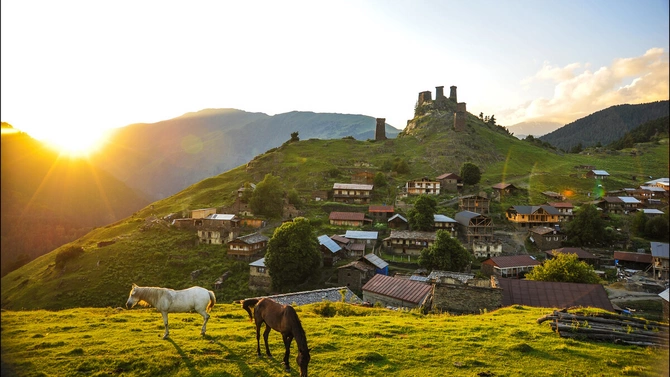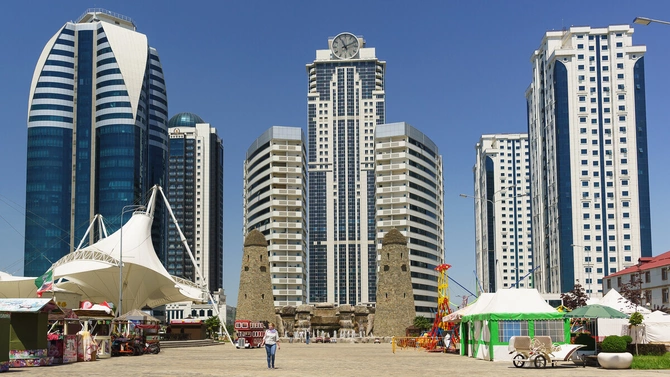
These are some of the most under-publicized and unforgettable sights in Europe. Join us as we explore the Towerhouses of the Caucasus.
Image: Kotenko Oleksandr/Shutterstock
Perhaps the most archetypal “Caucasian” building is the stone tower house or ‘Vainakh Tower.’ While best known in Georgia, such towers can also be found in various guises in the remote mountain villages of several republics in the North Caucasus. There, they are seen increasingly as a symbol of national consciousness. So much so that there are now several striking modern takes on the idea.

Image: Ana Flasker/Shutterstock
One of the most under-publicized yet unforgettable tourist sights in Europe is the knock-out vista that assaults the senses as one arrives at Ushguli. By some definitions, the continent’s highest permanently populated settlement, Ushguli, is slowly being discovered by the growing trickle of visitors that find their way to the Svaneti mountain region of northern Georgia, where hardy locals speak a language all of their own.

The tough residents of Ushguli live in their village year-round but outside access is often impossible in winter due to heavy snows. Image: OnurUygun/Shutterstock
The steeply sculpted shepherd meadows and backdrop of soaring peaks are spectacular enough as a setting, but what adds the special touch is Ushguli’s array of medieval stone towers. Known here as ‘koshki’ or ‘koshkebi,’ at least one such tower stands within almost every farmstead that makes up the village. Tapering slightly from a square base to an overhang of machicolations (slots from which to drop projectiles onto the heads of any attacker), most are around four stories high. They traditionally offered villagers protection from passing marauders: in so remote a spot, few attackers would be likely to hang around long enough to besiege such places for long. Tower houses were also useful places of refuge during blood feuds[1] – once an infamous aspect of Caucasian mountain culture.
Less than 20 years ago, Svaneti still retained an aura of danger with reports of kidnappings and lawlessness that discouraged outsiders from visiting. Around 2004, that was reversed, and since then, the area has been rapidly growing in tourist popularity. Those unprepared to walk (or drive the bone-shaking track) to Ushguli can now cruise painlessly by public transport to the larger town of Mestia, where there’s a growing array of hotels and eateries dotted between its selection of highly impressive tower houses.

Even if you’re not planning to hike around Swaneti’s more traditional hamlets, the regional ‘capital’ is still a fascinating place to see towerhouses while staying in comfort. Image: Evgeny Eremeev/Shutterstock
In recent years adventure tourists in Georgia have also started exploring the less famous mountain regions further east – notably Tusheti and Khevsureti. While the mountain vistas aren’t quite as jaw-dropping here, a big draw is the multi-day trek from the Tolkienesque seasonal settlement of Omalo to the brooding stone citadel of Shatili in Khevsureti. Taking around a week, hikers can stay most nights in homestays in the small hamlets en route, many of which have their own collections of tower houses. While some towers are derelict or have lost their upper sections, surviving towers here are often more tapered than their Svanetian cousins and topped with a pyramidal beehive-shaped crown of tiles.

Remote Omalo is the starting point for some of the Caucasus’ most satisfying treks. Image: Vakhtang Gvinianidze/Shutterstock
Omalo, Tusheti’s tiny ‘capital’ is an idyllic little place, partly perched on a rocky knoll with views for miles across sweeping valleys and forests. Feebly linked to the rest of Georgia by a precarious unpaved road, it’s a good place to find yourself a horseman (or woman) and hiking guide. However, if you’re a confident navigator (and know how to avoid the fierce sheepdogs), you could make unguided day walks yourself to timeless hamlets like Dartlo.

Dartlo is one of several Tusheti hamlets that is still populated in summer, though by late September the place will be deserted for the winter. Image: k_samurkas/Shutterstock
Continuing west of Girevi, the main trekking route becomes tougher and usually involves a night’s camping before attempting the breathless Atsunda Pass to Ardoti and, eventually, Shatili. The central stone citadel of the latter forms an almost complete fortress, popular with 1960s filmmakers but also with renegade fighters in the late 1990s. Rebels had crossed the Russian border through here, having been driven out of nearby Chechnya. These days Shatili is once again calm. The magnificent, hardly changed citadel accepts guests to sleep in some of its bare stone rooms.

Shatili, the gem citadel of Khevsureti, is only 3km across the mountains from Chechnya. Image: upslim/Shuttestock
Western visitors have generally been dissuaded from visiting the republics of the North Caucasus by complicated Russian visa processes and the memories of serious conflicts in the 1990s and 2000s. However, for those who manage to go - Dagestan, Chechnya and Ingushetia all have their fair share of fabulous tower house hamlets along with some remarkable modern twists on the concept.

Erzi in Ingushetia. Image: Irina Iarovaya/Shutterstock
The style of architecture is known as Vainakh or simply ‘Nakh,’ the general name also used for the Caucasian peoples who built them – a group which includes the nationalities Chechen, Ingush, Batsbi and others. Some tower houses are thought to have been built over 2000 years ago though the majority still standing date from between the 13th and the 17th centuries.

Targim in Ingushetia. Image: Wikimedia Commons
Ingushetia has a particularly fine array of depopulated old villages featuring tower houses that are similar in design to those of Tusheti, albeit sometimes taller and originally with bigger adjacent towers for living quarters (almost all now destroyed). Choice examples include Erzi and Targim, while Kahib in Dagestan is a classic example of a ghost ‘aul’ (fortified mountain village) with ruins that cling precariously to a remote shoulder of Caucasus crag.

Dagestan’s ghost aul village. Image: Anna Kostenko/Shutterstock
Further west in North Ossetia, the celebrated site known as Dargavs looks initially similar in design to a tower-house village with the same style of beehive tiling on a remarkable array of shorter, squatter towers. These, however, are tombs, not homes and the whole site forms a giant, lonely necropolis often nicknamed “The City of the Dead.”

Dargavs “City of the Dead”. Image: Georgy Golovin/Shutterstock
The capital of Ingushetia is a mini-city called Magas. If you glanced at a few statistics, you’d likely imagine that the place would be filled with ancient buildings. After all, locals are proud to relate how the city was founded on April 15, 943AD.

Magas’s Tower of Concord as shown on a Russian postage stamp. Image: Wikimedia Commons
And yes, there’s a magnificent stone tower here – a building so special that it featured on a 2014 Russian stamp. Known as Bashniya Soglasiya (the Tower of Concord), it’s a massive 99.97m-tall making it the world's highest Vainakh tower.

The Tower of Concord, the world’s tallest Vainakh Tower dominates the Ingush capital, Magas. Image: gazetaingush/Shutterstock
However, as impressive as it looks, the tower was only constructed in 2013, finally opening as an ethnographic museum in 2019. Indeed Magas itself is a complete reinvention, built from scratch since 1995, starting three years after Ingushetia split from Chechnya during the chaos of the post-Soviet conflicts. The ancient town of old Magas had been almost totally destroyed in 1239. New Magas is essentially a southern suburb of much bigger Nazran. It took over Nazran’s role as Ingush capital in 2002. Nazran itself has what is arguably the most imaginative neo-traditional Vainakh tower anywhere as its Deportation Monument.

Nazran’s deportation monument. Image: alloova/Shutterstock
The monument pays homage to all those deported from Ingushetia and Chechnya to Central Asia (and beyond) on February 23, 1944. The republics’ entire non-Russian population (between 500,000 and 650,000 people) was brutally forced into cattle trucks and windowless railway wagons[2] as a collective punishment for what Moscow considered collaboration with Nazi Germany during WWII. As many as 400,000 people are thought to have died in the transportation or because of terrible conditions suffered on arrival. Survivors were finally allowed to return to the Caucasus in 1957.
One of the reasons that Hitler had been interested in the region during WWII was the oil-rich area around Grozny, a city that became synonymous with violence and destruction during the 1990s. However, as reported recently, Grozny has risen like a phoenix from those conflagrations and now features a sparkling modern business district. Fronting the city’s main complex of glass towers is a fountain pool flanked by a pair of stone towers built in a somewhat approximate Vainakh style.

These are not likely to be enough to attract many tourists, but what would surely do so is the planned

Promotional video for the planned Akhmat Tower in Chechnya which is modelled on the general form of a Caucasian tower-house.
[1] Vengeance reprisals between families for crimes committed by close kin
[2] an example of one such train is displayed near the tower
Share on social media
